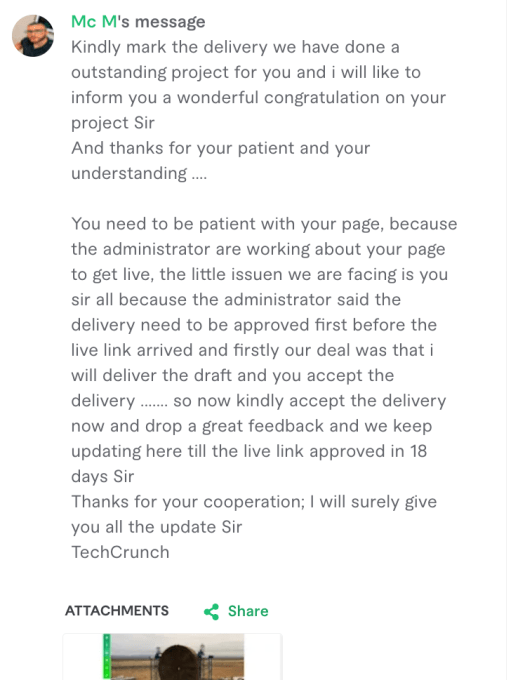I tried to buy a post on TechCrunch.com
A few times per day, I get a message that asks something along the lines of: “How much do you charge for a guest article on TechCrunch?” People are trying to get inbound links from TechCrunch for SEO reasons. The theory is: A link from TechCrunch gives your site trustworthiness in the eyes of Google, and so it’s worth doing. But is that what’s really happening here?
I know I should ignore these, after a few hundred of them, but then I received a message from someone who had paid someone on Fiverr, a site for freelancers, for a link on TechCrunch. He had gotten scammed and came to me to ask when I was going to publish the article. I was confused; apparently, someone had used my name as a contact at TechCrunch. Needless to say, I informed him that I couldn’t help and to take it up with Fiverr.
So then I wondered what would happen if I tried to buy an article on TechCrunch.
I spent $800 or so trying to get an article published on TechCrunch. Joke’s on me: I’m the one getting paid to publish articles on TechCrunch. Image Credits: Screenshot from Fiverr
A search on Fiverr showed dozens of people offering articles on this site. I engaged with a handful of them and paid them. I did this using my full, real name, too, so there was no confusion about who was asking.
Fiverr cleans house
Scammers came out in full force. “I have submitted this to my contact. It will take 16 days to publish, but please release the payment now, and I guarantee it will be published,” one replied. Asking for the funds to be released before the end result is the scam.
“The funds remain under a ‘pending’ status for a 14-day clearing period,” Fiverr explains on its website. “This timeline is for financial processing and buyer satisfaction guarantee.” In other words, when the sellers tell you you have to wait for 16 days, they’re not waiting for their inside contact to hit “publish,” they are waiting for the funds to clear.
“These services should have never made it onto our platform. Thank you for bringing this to our attention, as we’ve been able to update our tools to ensure this doesn’t happen again. We take this very seriously, and the services you mentioned have been removed,” a spokesperson for Fiverr told me. “We do see some of these services make it through our toolset as bad actors are trying to outsmart the system, but the team is proactively tracking and adapting to the techniques used in every possible way. When found, they are immediately taken down, and the seller is blocked. We continue to update our algorithms and automated tools to actively catch, remove and block these services before they reach the marketplace.”
Fiverr did clean up its act; today, three weeks after I spoke with Fiverr’s team, a search for “TechCrunch” gives zero results. That doesn’t mean the problem is solved, however; the scammers just moved on to different targets and are no longer promising articles on TechCrunch.

TechCrunch is no longer the spammer honeypot, but there’s a suspicious number of people still offering these services for other publications. Image Credits: Screenshot from Fiverr
Doubling down
The scammers I spoke with were willing to go to extraordinary lengths to keep their scams alive. Some created fake websites, saying that they had delivered the work. When I pointed out that a link to a site that didn’t have techcrunch.com in the URL wasn’t an article live on TechCrunch, I received some spurious arguments in return. Some sent screenshots of the article “published” on TechCrunch. The Photoshop jobs weren’t good, and of course the article couldn’t be found anywhere on the site. When challenged on that, I was told I didn’t know how to use Google. They got cagy when I suggested they could send me a link.

One of the scammers congratulated me on a successful project, supplying a “screenshot” of the article on TechCrunch. He was not able to provide a link to the article live on the site, which isn’t surprising, because the article is not on the site. Image Credits: Screenshot of the Fiverr messaging tool
One of the Fiverr scammers said his contact was Jagmeet — one of my esteemed colleagues, who would never do anything as dumb as accept money for a link on TechCrunch. I checked with Jagmeet and was informed that, yeah, of course he hadn’t done that. Then I received a message from “Jagmeet” on Telegram:

Will the real Jagmeet please stand up? Image Credits: Screenshot of Telegram
Of course, that was a trick question; I haven’t actually met Jagmeet in person, but the real Jagmeet would know that. This Fiverr scammer (“Kurt Dylan,” if you are reading this – Hi!) was particularly incompetent.

I called “Jagmeet” out on his attempted scam, and then realized that he wasn’t very good at keeping his persona, either. I screenshot the conversation and requested a refund from Fiverr. Which I received, of course. Image Credits: Screenshot of Telegram
When Fiverr finally shut down the account, after Dylan had tried to submit his work half a dozen times, and after I sent the screenshots to Fiverr, I received a final message from my new friend.

Sorry, “Jagmeet.” Image Credits: Screenshot
So who is running these scams?
One of the scammers who was willing to talk to me told me he was a 23-year-old man living in Lagos, Nigeria. He didn’t have a job, and he explained that he and a number of his friends were trying to get people to pay money for these interactions. It became clear, however, that it was simpler than some lone wolf scammer trying to make a quick buck; it transpired that he didn’t actually know that it isn’t possible for someone to publish an article on TechCrunch like this.
He was told by another person what to say and how to run these scams, on a multitude of platforms. I never got a firm confirmation on what was going on, but I got a very distinct impression that this was a form of organized crime. Indeed, he made it clear that when he got paid, he had to pay two-thirds of his earnings to a third party.
This was a theme that recurred from several of the scammers. They told me that they had to pay money to someone, and that I needed to pay them quickly, so as not to get them in trouble. When asked, they were vague about who this “someone” was, but it isn’t unreasonable to assume that a number of these scammers were being run by the same people who were the brains behind the operation.
“We have a Trust and Safety Team who work around the clock to respond promptly to any reports of inappropriate content as well as implement manual searches on the site,” the Fiverr spokesperson said. “Building trust in our platform continues to be a priority for Fiverr.”





